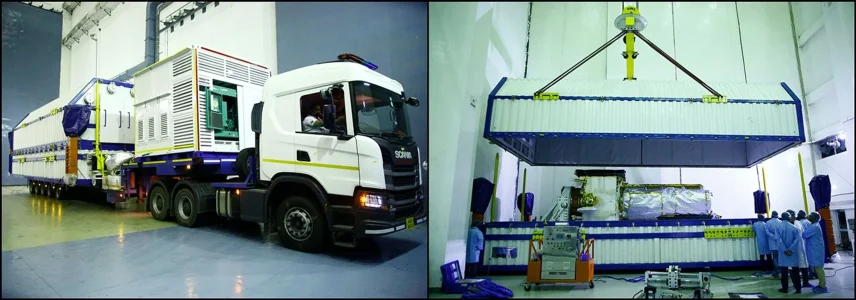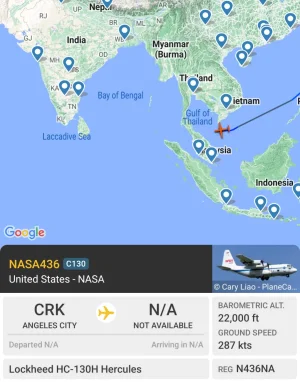You are using an out of date browser. It may not display this or other websites correctly.
You should upgrade or use an alternative browser.
You should upgrade or use an alternative browser.
NISAR - NASA-ISRO Synthetic Aperture Radar Mission (1 Viewer)
- Thread starter SKC
- Start date
More options
Who Replied?- Joined
- Jun 27, 2024
- Messages
- 2,981
- Likes
- 10,608
Yes I read the posts on r/isroSomeone in reddit posted that the NISAR launch has been delayed to 2025. Hope they are not right
It has been ongoing since a decade!!
- Joined
- Jun 27, 2024
- Messages
- 2,981
- Likes
- 10,608
View: https://www.youtube.com/live/fxAxLItUmcs?si=zwgOrpldgfREGyQF
Application of NISAR Mission for flood hazard management by Shri. C. M. Bhatt
- Joined
- Jun 30, 2024
- Messages
- 3,496
- Likes
- 30,204
- Joined
- Jul 5, 2024
- Messages
- 695
- Likes
- 2,706
- Joined
- Jul 5, 2024
- Messages
- 689
- Likes
- 3,182
- Joined
- Jun 27, 2024
- Messages
- 378
- Likes
- 2,075
© SpaceNews.com
NISAR planned to launch in March 2025 after antenna repairs
December 14, 2024
 The addition of a reflective coating on the spacecraft's large deployable antenna delayed the launch of NISAR. Credit: NASA
The addition of a reflective coating on the spacecraft's large deployable antenna delayed the launch of NISAR. Credit: NASA
WASHINGTON — A joint Earth science mission between NASA and its Indian counterpart is now scheduled to launch as soon as next March after being delayed to repair its main radar antenna.
In a presentation at the annual meeting of the American Geophysical Union here Dec. 11, Gerald Bawden, program scientist for the NASA-ISRO Synthetic Aperture Radar (NISAR) mission at NASA Headquarters, said the spacecraft is now scheduled to launch from India in a window that opens in late March.
NISAR was previously scheduled to launch in the spring of this year, but NASA announced in March that it would delay the launch to make repairs to the spacecraft’s 12-meter deployable reflector used by its main radar instrument. Engineers concluded that the reflector would get warmer than expected when in orbit immediately after launch while still stowed. Those repairs required shipping the antenna from India to California.
NASA completed those repairs by October, shipping the antenna back to India on a C-130 aircraft. The agency said then that NISAR would launch in early 2025 but was not more specific. NASA had said in July that the launch could not take place between October 2024 and February 2025 because the launch would place the spacecraft into an orbit with “periods of alternating sunlight and shadows” that would create temperature fluctuations affecting the reflector’s deployment.
Bawden said the issue with the antenna was discovered during tests of the spacecraft in a thermal vacuum chamber. “Some of the temperatures were higher than we expected them to be,” he said, “so what we decided to do is remove the reflector from NISAR and bring it back to the United States.”
The fix to the reflector, he said, involved placing strips of reflective tape on rods in the reflector that were black. “We are set now with NISAR,” he said. “The hardware is completely checked out.”
The spacecraft is in storage for two reasons. One is to wait until the eclipse period ends Feb. 8. The second is that the launch pad at India’s Satish Dhawan Space Centre that will be used for the Geosynchronous Satellite Launch Vehicle (GSLV) launching NISAR must first support another GSLV launch of a navigation satellite, NVS-02.
The NVS-02 launch is currently scheduled for mid-January. “Once it launches, it’s going to take six to eight weeks to refurbish the launch pad” before NISAR can launch, he said. The mission is currently targeting a launch no earlier than late March.
NISAR is a joint mission by NASA and the Indian space agency ISRO that will fly L- and S-band radars for global mapping of land and ice. The radars on NISAR will be capable of advanced radar imaging to support a wide range of Earth science needs, from measuring the flow rates of glaciers to volcanic activity. Bawden said science operations should begin about three months after launch.
NISAR also represents one of the biggest collaborations between NASA and ISRO to date, with NASA spending more than $1 billion in formulation and development of the mission. NASA is providing an L-band radar and engineering payload, while ISRO is providing the S-band payload, spacecraft bus and GSLV launch vehicle.
NISAR planned to launch in March 2025 after antenna repairs
December 14, 2024

WASHINGTON — A joint Earth science mission between NASA and its Indian counterpart is now scheduled to launch as soon as next March after being delayed to repair its main radar antenna.
In a presentation at the annual meeting of the American Geophysical Union here Dec. 11, Gerald Bawden, program scientist for the NASA-ISRO Synthetic Aperture Radar (NISAR) mission at NASA Headquarters, said the spacecraft is now scheduled to launch from India in a window that opens in late March.
NISAR was previously scheduled to launch in the spring of this year, but NASA announced in March that it would delay the launch to make repairs to the spacecraft’s 12-meter deployable reflector used by its main radar instrument. Engineers concluded that the reflector would get warmer than expected when in orbit immediately after launch while still stowed. Those repairs required shipping the antenna from India to California.
NASA completed those repairs by October, shipping the antenna back to India on a C-130 aircraft. The agency said then that NISAR would launch in early 2025 but was not more specific. NASA had said in July that the launch could not take place between October 2024 and February 2025 because the launch would place the spacecraft into an orbit with “periods of alternating sunlight and shadows” that would create temperature fluctuations affecting the reflector’s deployment.
Bawden said the issue with the antenna was discovered during tests of the spacecraft in a thermal vacuum chamber. “Some of the temperatures were higher than we expected them to be,” he said, “so what we decided to do is remove the reflector from NISAR and bring it back to the United States.”
The fix to the reflector, he said, involved placing strips of reflective tape on rods in the reflector that were black. “We are set now with NISAR,” he said. “The hardware is completely checked out.”
The spacecraft is in storage for two reasons. One is to wait until the eclipse period ends Feb. 8. The second is that the launch pad at India’s Satish Dhawan Space Centre that will be used for the Geosynchronous Satellite Launch Vehicle (GSLV) launching NISAR must first support another GSLV launch of a navigation satellite, NVS-02.
The NVS-02 launch is currently scheduled for mid-January. “Once it launches, it’s going to take six to eight weeks to refurbish the launch pad” before NISAR can launch, he said. The mission is currently targeting a launch no earlier than late March.
NISAR is a joint mission by NASA and the Indian space agency ISRO that will fly L- and S-band radars for global mapping of land and ice. The radars on NISAR will be capable of advanced radar imaging to support a wide range of Earth science needs, from measuring the flow rates of glaciers to volcanic activity. Bawden said science operations should begin about three months after launch.
NISAR also represents one of the biggest collaborations between NASA and ISRO to date, with NASA spending more than $1 billion in formulation and development of the mission. NASA is providing an L-band radar and engineering payload, while ISRO is providing the S-band payload, spacecraft bus and GSLV launch vehicle.
NISAR launch on July 30th. Is this a pic of the actual vehicle?
View: https://x.com/ISROSpaceflight/status/1941100154595283423
View: https://x.com/ISROSpaceflight/status/1941100154595283423
- Joined
- Jun 27, 2024
- Messages
- 2,981
- Likes
- 10,608
Updates from May from the official NISAR project website of Nasa:
Link: NASA-ISRO Earth-Observing Satellite Arrives at Indian Launch Site

Link: NASA-ISRO Earth-Observing Satellite Arrives at Indian Launch Site

NISAR made the two-day, 220-mile (360-kilometer) trip from the ISRO Satellite Integration and Test Establishment (ISITE) in Bengaluru by truck (left) in a specialized shipping container. It arrived on May 15 at the agency’s launch facility, Satish Dhawan Space Centre, where it was unpacked (right) - ISRO
The NISAR (NASA-ISRO Synthetic Aperture Radar) mission, an Earth-observing radar satellite jointly developed by NASA and the Indian Space Research Organisation (ISRO), moved another step closer to launch last month when it arrived safe and sound at Satish Dhawan Space Centre on India’s southeastern coast. Home to ISRO’s launch facilities, the center will host the satellite’s liftoff, slated for July.
Prior to arriving at the launch site on May 15, NISAR was at the ISRO Satellite Integration and Test Establishment in Bengaluru. Engineers from ISRO and NASA’s Jet Propulsion Laboratory in Southern California, which manages the mission for NASA, had been working together there since March 2023 on bringing together components and assembling the satellite. They also tested it to ensure it can withstand the rigors of launch and function properly in orbit.
In the early morning of May 14, crews placed the satellite in a specialized container and transported it about 220 miles (360 kilometers) by truck to the space center, arriving the following day. It will be placed in its launch fairing and mounted atop an ISRO Geosynchronous Launch Vehicle Mark II rocket in preparation for launch.
In orbit, NISAR will collect an unprecedented amount of information about our planet’s environment. It will scan nearly all of Earth’s land and ice surfaces twice every 12 days, providing insights into the expansion and contraction of ice sheets, sea ice, and glaciers, the deformation of its crust due to natural hazards, as well as natural and human changes to Earth’s terrestrial ecosystems.
These measurements will be carried out by two radar systems — an L-band system built by JPL, and an S-band system constructed by ISRO’s Space Applications Centre in Ahmedabad. Not only is NISAR the first satellite to carry two radars working at two different frequencies, but the mission also marks the first hardware collaboration on an Earth-observing mission between the two space agencies.
The NISAR mission marks a significant milestone in NASA’s ongoing collaboration with ISRO, indicative of strong bilateral relations between the United States and India. In February of this year, President Donald J. Trump met with Prime Minister Narendra Modi of India. During the meeting, the two leaders hailed this year as a pioneering year for U.S.-India civil space cooperation and reaffirmed their mutual support for the NISAR mission. The leaders committed to further commercial space collaboration through industry engagements in conventional and emerging areas, such as connectivity, advanced spaceflight, satellite and space launch systems, space sustainability, and advanced space manufacturing.
- Joined
- Jun 27, 2024
- Messages
- 2,981
- Likes
- 10,608
From ISRO Subreddit, r/ISRO:
Link: New NOTAM for GSLV-F16 / NISAR launch is out. Enforcement duration 1130-1530 (UTC), 16 July to 14 August 2025.
Link: New NOTAM for GSLV-F16 / NISAR launch is out. Enforcement duration 1130-1530 (UTC), 16 July to 14 August 2025.
A1877/25 (Issued for VOMF PART 1 OF 2) - GSLV-F16 ROCKET LAUNCH FM SHAR RANGE, SRIHARIKOTA WILL TAKE
PLACE AS PER FLW DETAILS.THE LAUNCH WILL BE ON ANY ONE
OF THE DAY DRG THIS PERIOD.ACTUAL DATE OF LAUNCH WILL BE
INTIMATED ATLEAST 24 HR IN ADVANCE THROUGH A SEPARATE NOTAM.
LAUNCH PAD COORD: 134312N0801348E
NO FLT IS PERMITTED OVER THE DNG ZONES.
A)DANGER ZONE -1:IS A CIRCLE OF 10 NAUTICAL MILES AROUND THE
LAUNCHER.
B)DANGER ZONE -2:IS AN AREA BOUNDED BY FOLLOWING COORD:
I.103000N 0824500E
II.105000N 0830500E
III.085533N 0844109E
IV.091743N 0834543E
V.103000N 0824500E
RTE AFFECTED IN CHENNAI FIR:
W20, L896, N563, N564, Q11, Q23, Q24, V4, V9, T3
CLOSURES/ALTN RTE FOR OVERFLYING:
1. W20 NOT AVBL BTN MMV-KAMGU
ALTN: MMV-DCT-DOHIA-DCT-RAMDO-DCT-KAMGU
2. Q24 NOT AVBL BTN MMV-KAMGU
ALTN: MMV-DCT-DOHIA-DCT-RAMDO-DCT-KAMGU (UNI DIRECTIONAL)
PART 1 OF 2. 1130-1530, 16 JUL 11:30 2025 UNTIL 14 AUG 15:30 2025. CREATED:
19 JUN 10:22 2025
That's good news, hope they surprise us and launch it before the stated launch date of July 30th!From ISRO Subreddit, r/ISRO:
Link: New NOTAM for GSLV-F16 / NISAR launch is out. Enforcement duration 1130-1530 (UTC), 16 July to 14 August 2025.
Users who are viewing this thread
Total: 1 (members: 0, guests: 1)
Latest Replies
-
Indian Infrastructure & Discussion
- haldilal
-
CI/CT Operations
- COLDHEARTED AVIATOR
-
Barbaric Paper Dragon: Musings of CCP
- crazywithmath
-
Operation Sindoor & Aftermath
- fire starter
-
Air India AI 171 Crash in Ahmedabad
- trombone
-
Jokes Thread
- shade2
-
Indian Air Force: News & Discussions
- Interested
-
China Watch
- RoaringTigerHiddenDragon

